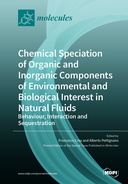Explore

Chemical Speciation of Organic and Inorganic components of Environmental and Biological Interest in Natural Fluids
Francesco Crea and Alberto Pettignano
2020
0 Ungluers have
Faved this Work
Login to Fave
The International Union of Pure and Applied Chemistry (IUPAC) defines the term “speciation” as the distribution of an element amongst defined chemical species in a system, while the process leading to quantitative estimation of the content of different species is called speciation analysis. The chemical speciation of elements in natural waters and biological fluids is a key topic, essential for discussing the chemical reactivity of constituents in these systems. It is well understood that it is the chemical form of a metal or metalloids that determines its reactivity, lifetime, and fate in the environment. Chemical speciation now involves various sectors of the sciences, from chemistry to biology, biochemistry, and environmental sciences, since—as is well known—the total concentration, alone, of an inorganic or organic component (metal or ligand) in a multicomponent natural system (fresh water, sea water, biological fluids, soil, etc.) is insufficient for a comprehensive understand of its behavior in those contests.
This book is included in DOAB.
Why read this book? Have your say.
You must be logged in to comment.
Rights Information
Are you the author or publisher of this work? If so, you can claim it as yours by registering as an Unglue.it rights holder.Downloads
This work has been downloaded 280 times via unglue.it ebook links.
- 220 - pdf (CC BY-NC-ND) at Unglue.it.
Keywords
- 3-hydroxy-4-pyridinone
- acid–base properties
- affinity
- alcoholic liver disease
- Alcoholism
- Aluminum
- amyloid-?
- antimony
- arsenic
- biomimetic complexes
- brain toxicity
- brain trace element concentration
- chromium speciation
- Copper
- deficiency
- dependence on ionic strength
- enthalpy and entropy changes
- epinephrine
- evolved gas analysis
- extended Debye–Hückel
- field
- hazardous elements
- heavy metals interactions
- Herbs
- Honeybee
- HR-CS FAAS
- hyphenated technique
- ICP-MS
- ICP-OES
- Iron
- magnesium
- Manganese
- Melissa officinalis
- Mercury
- metal complexation
- migration
- Mo(VI) complexes
- n/a
- peptide hydroxamic acids
- pesticide
- photosynthesis indicators
- Rh(III)-based half-sandwich complexes
- Risk
- Ru(II)-
- Ru(II)-, Rh(III)-based half-sandwich complexes
- selenium
- sequestering ability
- Silicon
- solution equilibrium
- speciation
- speciation analysis
- specific ion interaction theory
- TI-EGA-MS
- toxic cations
- toys safety
- trace elements
- van’t Hoff equation
- Zn-complexation
- Zn2+
Links
DOI: 10.3390/books978-3-03928-453-5Editions


